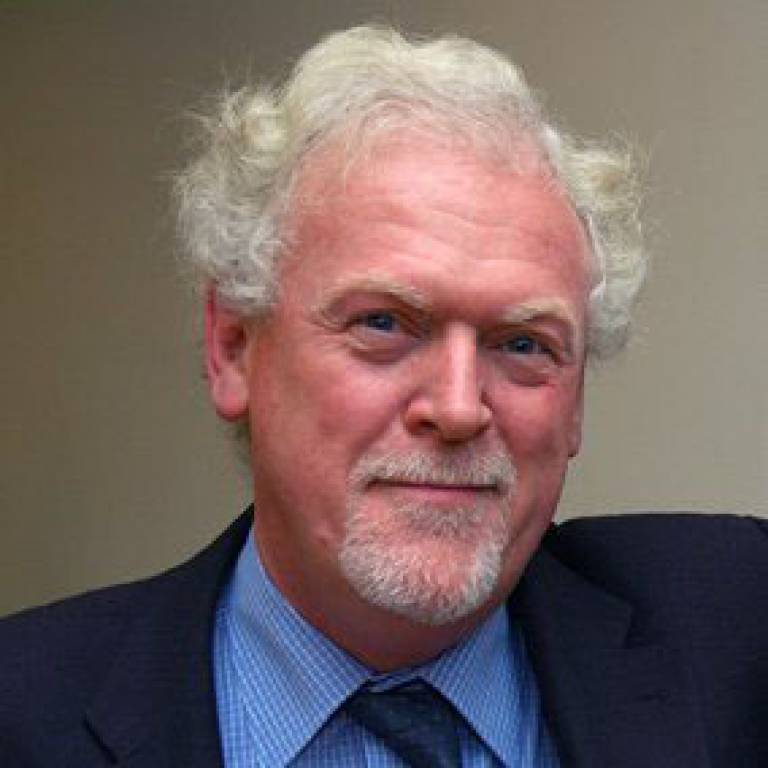Professor Michael Horton: medic, scientist and entrepreneur
15 April 2010
A world-leading clinical expert in bone research and a pioneer in the emerging field of nanomedicine, Professor Michael Horton has sadly died from cancer, aged 61.

Colleagues from the London Centre for Nanotechnology here pay tribute to his immense contribution to bone research and UCL life.
Mike's long and distinguished clinical and scientific research career provided a fundamental understanding of disease on cellular and molecular length scales, and has led to new diagnostics and treatments for osteoporosis. His lasting legacy is the London Centre for Nanotechnology (LCN), a major interdisciplinary joint effort between UCL and Imperial College London, which he co-founded and successfully led as the first Director for Life Sciences over the last years of his career.
Born in 1948, Mike trained in medicine at St Bartholomew's (Barts) Hospital Medical College, London. He first specialised in haematology, rapidly establishing himself as a rising star and was swiftly promoted to Senior Lecturer and Consultant Haematologist at Barts.
During a sabbatical leave in 1983, Mike undertook research in molecular biology at renowned institutions such as the Cambridge MRC labs, Genentech in San Francisco, and the Meikai University in Japan. While at the MRC and Genentech, Mike investigated potential clinical use of antibodies against the main adhesion protein of bone-resorbing cells (one of his discoveries). Mike returned to Barts in 1984 as Principal Scientist and Head of I.C.R.F. Haemopoiesis Research Group (now Cancer Research UK).
In 1995 he took up a Chair at UCL and founded the Bone and Mineral Centre and the Sackler Institute of MusculoSkeletal Research in the Department of Medicine. He was recognised internationally for his work on the molecular cell biology of healthy and diseased skeletal tissues. His research identified the proteins that mediate adhesion of bone-resorbing cells, known as osteoclasts, to skeletal tissues. These proteins, integrins, proved to be pivotal mediators of osteoclast function and were subsequently used in the study and control of bone disease. Another seminal contribution, published in the leading journal Science in 1997, identified the transcellular pathway through which degraded bone matrix is removed from the skeleton. Both areas of research opened the way for anti-osteoporotic therapies targeting the bone-resorbing osteoclasts.
Throughout his career in research, Mike managed to preserve a boyish enthusiasm for new technologies. This formed an integral part of his research commitment and led him to carry out some of the earliest laser scanning confocal microscopy studies of bone cells, laying the foundations for his discovery of trafficking of bone material through bone-resorbing cells in 1997.
Mike had wide-ranging interests outside his specific field, which led him to become one of the pioneers of the biological use of atomic force microscopy, a technique originally developed for imaging the atomic arrangements of semi-conductor surfaces. This would eventually result in the development of one of the first atomic force microscope-confocal imaging systems in the world, a method with significant applications in cell biology, single-molecule cell physiology and drug development at the nanoscale.
Mike successfully fostered and led a creative interdisciplinary environment where young scientists could flourish. It was his ability to work across and beyond traditional boundaries with chemists, engineers and physicists which was instrumental to the foundation of the LCN. According to Guillaume Charras, PhD student with Mike and now Lecturer at the LCN: "Mike was always full of enthusiasm for research and quick to grasp the potential of any new technology. He was a caring mentor who sought to push his students to achieve their full potential and made sure they were given the opportunity to shine". Rachel McKendry, Reader in Biomedicine at the LCN said: "It was a real privilege and pleasure to work with Mike over the past seven years. He was an inspiration, a mentor and a friend. His sharp intellect, phenomenal breadth of knowledge and warm Geordie spirit will be deeply missed."
Mike was nationally and internationally known for his work in the field of nanomedicine. He was also a Co-Director of the Engineering and Physical Sciences Research Council Interdisciplinary Research Collaboration in Nanotechnology (2002-07) run by the Universities of Cambridge, Bristol and UCL, and led several major EU programmes and industrial collaborations.
His significant work with (inter)national government bodies and companies led to the development of the LCN's spin-out consulting company, Bio-Nano Consulting, funded by the Departmet of Trade and Industry and the London Development Agency.
Gabriel Aeppli, Director of the LCN, said: "Mike provided the LCN with its unique competitive advantage in biomedicine. In addition, he was one of the most gifted experimentalists that I have ever met, a superb critical as well as lateral thinker, and a friend on whom I would rely for sincere advice on any subject. He is irreplaceable."
UCL President and Provost Professor Malcolm Grant paid tribute: "There are two types of people at UCL: those whom UCL makes great and those that make UCL great. Mike was clearly in the latter category."
In 2008 Mike returned to his beloved Northumberland to pursue his passion for gardening. He is survived by his wife Susan, mother, two children Benjamin and Rachel, and six grandchildren.
Professor Michael A. Horton Born 6 May 1948. Died Sunday 11 April 2010.
 Close
Close

